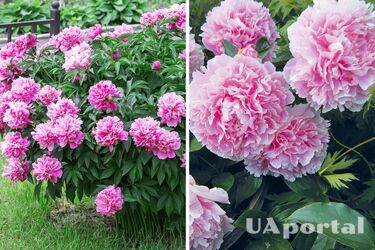The decoration of your garden: How to properly plant and care for peonies so that they bloom beautifully

Peonies are luxurious flowers that can add a sense of sophistication and grandeur to your garden. These plants have large, bright flowers with an unsurpassed aroma and a variety of colors, from white and pink to red and even purple. If you dream of a luxurious garden with large flowers, peonies are a great choice.
Read also: How and when to plant marigolds correctly
Planting peonies
The best time to plant peonies is in the fall or spring. They grow best in sunny locations with fertile soil that has a good drainage system.
The basic steps for planting peonies are as follows:
- Prepare the planting site: choose a sunny spot in the garden with enough space for the peony's root system to grow. The approximate size of the planting hole should be larger than the size of the root system of the seedling;
- Prepare the soil: Add compost or humus to the soil to improve its fertility and drainage properties;
- Submerge the roots: carefully plant the peony seedling in the prepared hole, straighten its roots and cover it with soil so that the seedling's buds are covered by only 3-5 cm;
- Water: Pour water over the seedling after planting, and then water it regularly, especially in the first weeks after planting, to promote the growth of the root system.
Read also: How often to water tulips to make them bloom longer
Caring for peonies
Peonies need some attention and care to bloom beautifully.
Here are some important tips for caring for peonies:
- Watering: Peonies need abundant watering, especially during the period of active growth and flowering. It is important to keep the soil moist, but do not flood it, as this can lead to root rot. Provide regular watering, especially during dry periods;
- Fertilizers: Peonies need fertilizer to stimulate growth and bloom. Use organic or mineral fertilizers that contain nitrogen, phosphorus, and potassium. Feed peonies in the spring, before growth begins, and in the summer, during flowering;
- Garter: Large peony flowers can wobble and break, so it is recommended to tie them to a support. Use soft ribbons or special ties to avoid damaging the stems;
- Removing wilted flowers: After flowering, remove wilted flowers to encourage the formation of more buds and increase next year's blooms;
- Wintering: Peonies need to rest in winter, so it is necessary to give them a period of hibernation. They can overwinter in the soil, but it is recommended to cover them with mulch to protect them from freezing in winter. It is also possible to dig up the root system of peonies, especially in regions with a cold climate, and store it in a cool, dry place until spring, when you can plant the plant back outdoors;
- Protection against diseases and pests: Peonies can be vulnerable to some diseases and pests, such as powdery mildew, white flies, fungal diseases, etc. Regularly check the plants for signs of disease or pests, and apply appropriate control measures in time, such as mulch, insecticide or fungicide treatments;
- Pinching: To promote denser growth and richer blooms, you can pinch the tops of the shoots at an early stage of growth. This will help the plant branch out and form more buds;
- Root system care: The root system of peonies is essential for the health and growth of the plant. Regularly monitor the condition of the roots, remove dry and damaged roots, and ensure their additional growth with additional watering and fertilizer.
As you know, the sowing season begins in spring, nature comes to life, and insects return with it. Some of them, such as ants, can harm your plants, so you need to fight them. How to do it, read in our article.
If you want to receive the latest news about the war and events in Ukraine, subscribe to our Telegram channel!
